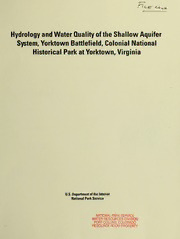
Hydrology and water quality of the Shallow Aquifer System, Yorktown Battlefield, Colonial National Historical Park at Yorktown, Virginia PDF
Preview Hydrology and water quality of the Shallow Aquifer System, Yorktown Battlefield, Colonial National Historical Park at Yorktown, Virginia
Fl L-&- c-q Hydrology and Water Quality of the Shallow Aquifer System, Yorktown Battlefield, Colonial National Historical Park at Yorktown, Virginia U.S. Department ofthe Interior National Park Service NATIONAL PARK SERVICE WATER RESOURCES DIVISION FORTCOLLINS, COLORADO RESOURCE ROOM PROPERTY Digitized by the Internet Archive in 2012 with funding from LYRASIS Members and Sloan Foundation http://archive.org/details/hydrologywaterquOOspei Hydrology and Water Quality of the Shallow Aquifer System, Yorktown Battlefield, Colonial National Historical Park at Yorktown, Virginia By Gary K. Speiran and Michael L. Hughes U.S. Geological Survey 1730 East Parham Road Richmond, VA 23228 September 2001 InteragencyAgreement IA 4000-9-9013 NATIONAL PARK SERVICE WATER RESOURCES DIVISION FORTCOLLINS, COLORADO RESOURCE ROOM PROPERTY National Park Service Northeast Region Office Stewardship and Partnership 200 Chestnut Street Philadelphia, PA 19106 CONTENTS Summary 1 Introduction 2 Purpose and scope 4 Previous investigations 4 Description ofstudy area 5 Physiography 5 Landcover 8 Geology 8 Soils 11 Hydrology 12 Processes affecting ground-waterquality 13 Acknowledgments 16 Methods 16 Ground-waterhydrology 18 Aquifers andconfining units 18 YorkCounty shallow aquifersystem (undivided) 18 Columbia aquifer 18 Cornwallis Caveconfining unit 20 CornwallisCave aquifer 21 Yorktown confining unit 22 Yorktown-Eastoveraquifer 22 Conceptualized ground-waterflow 22 Ground-waterquality 27 Columbiaaquifer 27 Cornwallis Cave aquifer 33 Discussion 36 Future monitoring andresearch 38 Monitoring 39 Geohydrologic framework 39 Connection betweenthe shallow aquifersystem and streams, wetlands, and associated habitats 40 References 41 FIGURES 1. Locationofstudy areanearYorktown Battlefield, Colonial National Historical Park atYorktown, Virginia 3 2. General locationofscarps andterraces 6 3. Deep valley and steep valley wall ofthe YorkRiverBasin (A) and a less deeply incised valley and more gently sloping valley wall oftheJames RiverBasin (B) 7 4. Fields maintainedfortheirhistorical significance, forests, andthe visitorcenter 9 5. Relation between geology and geohydrologic units 10 6. Diffuse dischargeofaseep (A) and the focuseddischarge ofaspring (B) 14 7. Locationofgeohydrologic sections, selected wells andboreholes having geohydrologic data, andselectedsprings having water-quality data 17 8. Geohydrologic sections A-A' andB-B' 19 9. Altitudeoftop ofYorktown confining unit 23 10. Altitudeoftop ofYorktown-Eastoveraquifer 24 11. Generalizedrelation between geohydrologic units and ground-waterflow paths 25 12. Specific conductance, pH, and concentrations ofcalcium, bicarbonate, silica, and iron in water fromselected springs discharging fromthe ColumbiaaquiferandCornwallis Cave aquifer 28 13. Concentrationofmajorions in waterfrom selected springs 29 14. Concentrations ofnutrients in waterfrom selected springs discharging from theColumbia aquiferand Cornwallis Cave aquifer 34 15. Concentrations ofnitriteplus nitrate in waterfromselectedsprings 37 Al. LocationofYorktown Battlefield, the GraftonPonds Natural AreaPreserve, and nearby physiographic features, Colonial National Historical Parkat Yorktown, Virginia 45 A2. Selectedpossiblehydrologic relations between the seasonal ponds andthe shallow aquifer; (A)theColumbia aquiferperched andhaving ahigh watertable (the upperpartoftheCornwallis Cave aquiferis unsaturated), (B) theColumbiaaquiferperchedand having a declining water table, (C) theseasonalpondperched, and (D) theColumbiaand Cornwallis Caveaquifers saturated withadeclining watertable 47 A3. Generalizedrelationbetweengeology and geohydrologic units and ground-waterflow paths 55 . TABLES 1 Majorsoils and selected soil characteristics nearYorktown Battlefield, Colonial National Historical Park at Yorktown, Virginia 12 2. Record ofcontrol wells and geohydrologic data 20 3. Water-quality data from selected seeps and springs in April 2000 30 PROJECT STATEMENTS Effects ofHydrology on the Hydroperiods andWaterQuality ofSinkhole Ponds, Yorktown Battlefield, Virginia 43 Abstract 44 Problem 44 Projectdescription 48 References 50 Ranking criteria 50 EffectsofGround-WaterDischargefrom the Shallow AquiferSystemontheWaterQuantity and Quality ofNontidal Streams andRiparianWetlands, YorktownBattlefield,Virginia 52 Abstract 53 Problem 53 Projectdescription 56 References 57 Ranking criteria 57 VI CONVERSION FACTORS, VERTICAL DATUM, AND ABBREVIATED WATER-QUALITY UNITS Multiply By Toobtain MeasurementsReported in Inch-Pound Units Length inch(in.) 25.4 millimeter(mm) foot(ft) 0.3048 meter(m) mile(mi) 1.609 kilometer(km) Area acre 0.4047 hectare(ha) Velocity inchperhour(in/h) 25.4 millimeterperhour(mm/h) footperday(ft/d) 0.3048 meterperday(m/d) HydraulicConductivity footperday(ft/d) 0.3048 meterperday(m/d) Measurements Reportedin International System Units Length micrometer(u.m) 0.0000003937 inch(in.) millimeter(mm) 0.0003937 inch(in.) Watertemperatureis reportedindegreeCelsius(°C), which canbeconvertedtodegree Fahrenheit (°F) bythefollowing equation: °F= 1.8(°C)+32 Verticaldatum: Inthis report, "sea level" referstotheNationalGeodeticVertical Datumof 1929-ageodeticdatumderivedfrom ageneral adjustmentofthefirst-orderlevel netsofthe United StatesandCanada, formerlycalled Sea Level Datumof 1929. Abbreviatedwater-qualityunits: Chemicalconcentrationis reportedin milligrams perliter(mg/L) ormicrogramsperliter(ug/L). Milligrams per literisaunitexpressingtheconcentration ofchemicalconstituentsinsolutionas mass (milligrams) ofsolute perunitvolume (liter)ofwater. One thousandmicrogramsperliterisequivalenttoonemilligramperliter. Forconcentrationslessthan7,000mg/L,thenumericalvalueisthesameas forconcentrationsin partspermillion. Specificconductanceofwateris reportedinmicrosiemens percentimeterat25degreesCelsius(uS/cm). VII
